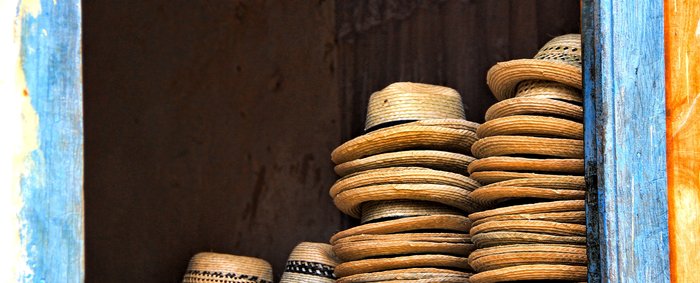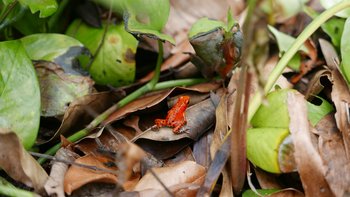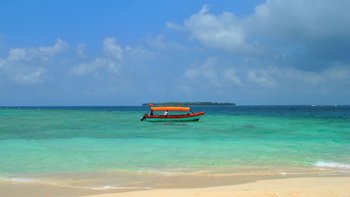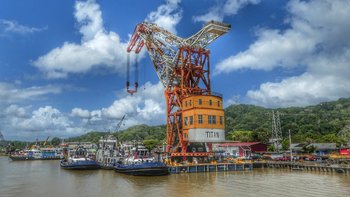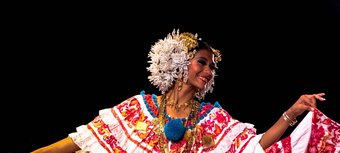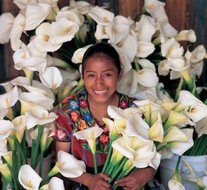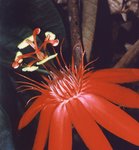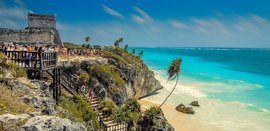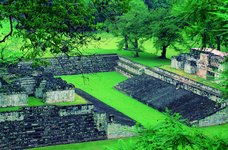Travel in Panama with Rainforest, Volcanoes & Caribbean Coast - INTI Tours
Much more than a straw hat and a canal...
Panama - that is the bridge between Central and South America. The country occupies the narrowest part of the Central American land bridge, which is broken here by the Panama Canal and thus connects the Pacific with the Atlantic. So a cruise on a section of the Panama Canal is certainly an impressive experience.
But what else does the small state have to offer? The country is truly still a treasure chest with many undiscovered treasures. Experience much more than straw hats and canals on our trips to Panama... - lush rainforest, mountainous volcanic landscape and picturesque Caribbean coast. Enjoy the so-called Pearl Islands in the south of the Gulf of Panama - an archipelago of 227 islets with fantastic nature. Relax on the picturesque Caribbean coast on the paradisiacal islands of Bocas del Toro and on the still very pristine San Blas Islands.
Janosch's "Oh how beautiful is Panama!" with the lovable tiger duck is certainly familiar to us all... Let yourself be enchanted by the many surprises of this almost undiscovered travel destination.
Welcome to Panama!
Country information Absolutely worth seeing Dates and facts Travelling in Panama Addresses
Our types of travel in Panama
Examples of individual dream trips in Panama
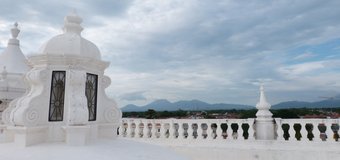
Individual Rental Car Tour through Nicaragua and Panama
Let yourself be inspired by unspoilt nature, coffee and chocolate factories and many possible activities. The icing on the cake at the end of the trip is the partial crossing of the Panama Canal!
25 days Rundreise 2 up to 6 travellers
upon request
You might also like this...
Country information on PANAMA: „Much more than a channel...
Panama forms the bridge between Central and South America. The country borders Costa Rica to the west, the Pacific Ocean to the south, Colombia to the east and the Atlantic Ocean to the north. It covers 75,517 square kilometres, of which 1,432 square kilometres belong to the so-called Canal Zone. Panama occupies the narrowest part of the Central American land bridge, which is broken here by the Panama Canal and thus connects the Pacific with the Atlantic. After independence from Spain, Panama became part of Greater Colombia. It was not until 1903 that Panama gained its independence from neighbouring Colombia, when US troops occupied the area around the canal, which was under construction. Afterwards, the country was under the influence of the USA for a long time, under whose sovereignty the Panama Canal was opened in 1914. Since then, it has been one of the most important waterways in the world, with around 14,300 ships a year travelling along its 82 kilometres. In 1999, the USA finally ceded full control of the Panama Canal to the state of Panama. Thanks to the revenues from the canal, Panama is now one of the richest countries in Latin America. As a natural land bridge, Panama connects North and Central America with South America. As a result, some animal species from both parts of the Americas can be found here, such as the agoutis, the tapir or the harpy bird of prey. It is estimated that around 300,000 species of insects live in Panama. Almost 30 % of the land area has been set aside in 15 nature parks for the protection and preservation of native flora and fauna. Natural regions worth visiting in Panama are located on the Pacific coast, on the Caribbean coast and on the Azuero peninsula; the province of Darien with its almost impenetrable tropical rainforest should not be visited for safety reasons.
Capital Panama City:
Panama City is located on the Pacific Ocean and forms the southern entrance to the Panama Canal. The metropolis is home to almost 1.5 million inhabitants and is the economic and financial centre of the republic. In the country itself, Panama City is always referred to simply as Panama.
Absolutely worth seeing:
- A trip on a ship through part of the Panama Canal is, of course, the highlight of a visit to the capital. You can cruise along the way to the Pedro Miguel Locks and through to the Pacific Ocean. Marvel at the engineering feats of several locks up close and see the Bridge of the Americas. Built by the US in 1962, this architectural masterpiece rises above the Pacific mouth of the Panama Canal. The legendary "8th Wonder of the World" will leave you in awe as the floating giants are ferried from the Atlantic Ocean across Lago Gatún to the Pacific Ocean. A 4-, 5- and 6-hour trip is available.
- Even from a distance, you can see the breathtaking backdrop of skyscrapers, noble villas and green hills of the metropolis. The bridge spans the canal in a high arch and connects what it separates. Next to the rather hectic business and banking district of the booming metropolis of Panama City, the old town of San Felipe is an oasis of tranquillity with Latin American flair. The old houses hint at much of the past splendour. Walking along the Calzada de Amador, you can enjoy the view of the skyscrapers both during the day and at night.
- The old town of Casco Viejo is perhaps the most beautiful part of Panama City and an ideal starting point for exploring. Buildings from the 17th and 18th centuries, including the cathedral and the San José Church with its magnificent altar, can be admired.
- A visit to the ruins of Panamá Viejo will immerse you in the region's past in the 16th century, when it was the trading hub for the Spanish of all Central America. On a clear day, enjoy the wonderful view over the city.
- The Cerro Ancón mountain is wonderful for a short hike and at the top you are rewarded with a fantastic view over Panama City.
- Two easy hiking trails lead through the beautiful Parque Natural Metropolitano.
- Frank Gehry's colourful Biomuseo is an irresistible colourful photo motif. Eight galleries showcase the biodiversity of the entire world and celebrate flora and fauna.
Pacific coast of Panama:
The beautiful beaches and resorts along Panama's Pacific coast are all located between Panama City and the border with Costa Rica. Farallón, about 90 minutes west of the capital, is where most of the big beach hotels are located.
Absolutely worth seeing:
- Santa Clara, Pedasí, Playa Venao and Las Lajas are home to some of Panama's most beautiful beaches. There are also three unspoilt island and nature paradises off the coast.
- The Pearl Islands are a group of 227 islands in the south of the Gulf of Panama. The name Pearl Islands comes from the Indians who used to live there, who dived for pearl oysters and traded with them. They are of volcanic origin, and some have freshwater springs. There is a diverse flora and fauna typical of the rainforest and the fishing grounds around the islands are considered to be extremely rich in species.
- About 50 kilometres off the coast, in the Gulf of Chiriquí, lies the island of Coiba, which together with 38 islands forms the Coiba National Park. The island has a terrifying past, having been Panama's most notorious prison from 1919 to 2004 and even a camp for political prisoners during the military dictatorships. Today, Coiba seems like paradise. The island has the largest untouched rainforest in all of Central America, about 80 percent of which has been completely spared. White icing sugar beaches with palm trees and crystal blue water are inviting.
- Boca Brava is also located in the Gulf of Chiriquí. This idyllic island is only ten minutes away from the mainland by boat and is still considered an insider tip. Most of Boca Brava is covered by dense rainforest, with mangrove forests spreading out towards the sea. Animals such as howler monkeys, tucans, sloths, macaws and sea turtles can be observed along the small hiking trails. Humpback whales migrate through the Gulf of Chiriquí from July to October during their annual migration. Boca Brava has white sand beaches and coral reefs, making it a perfect destination for snorkelling and relaxing. Excursions can also be made to neighbouring islands and beaches. Boca Chica, Isla Palenque, Isla Parida, Islas Secas, Islas Ladrones are not far from Boca Brava.
- On the Azuero Peninsula you have arrived in the most traditional region of all Panama, it is also called the "cultural heart". Towards the south, it becomes greener and greener with lush mountain forests and mangrove areas spread out near the sea. Several small, very colonial villages lie along the road. Almost every village has a local culinary speciality or something else to offer. Pollera costumes are also made on the peninsula, as well as devil masks and other handicrafts made of clay and wood. Pedasi, in the south of the peninsula, is a small pretty village whose Playa Venao has hosted international surfing competitions several times. About 20 minutes by boat off the coast is the island of Iguana, a nature reserve and paradise for snorkelling, beach and nature lovers. In addition to a colourful underwater world, one encounters iguanas, crabs and a variety of birds.
Panama's Caribbean Coast:
The picturesque Caribbean coast includes the paradisiacal island worlds of Bocas del Toro on the border with Costa Rica, as well as the still very pristine San Blas Islands, inhabited by Kuna Indians, which border Colombia. Also on the Caribbean coast is Panama's second largest city, Colón, which is home to a globally important free trade port, but is otherwise considered rather dirty and not very safe.
Absolutely worth seeing:
- The Bocas del Toro archipelago is a unique natural paradise. The archipelago consists of 9 islands and 251 coral islands. The main town of Bocas del Toro is located on Isla Colón, which is characterised by a relaxed Caribbean flair and lively everyday culture. In addition to pristine coral reefs, white sandy beaches and caves, the archipelago is also home to interesting wildlife including sloths, monkeys, toucans, parrots, iguanas and turtles. The Bastimentos Marine Park attracts visitors with its colourful underwater world.
- The San Blas Islands border Colombia and are home to the Kuna Indígena, which is why they are also called "Kuna Yala". Of the 365 beautiful islands, many consist only of a patch of white beach with a coconut tree and surrounded by a dreamlike turquoise sea. Only a few of the islands are populated. The coral reefs are perfect for snorkelling. Indigenous culture, seclusion, tranquillity and enjoyment - this is what San Blas is all about.
Panama's interior:
In the far western part of Panama, fairly centrally located on the isthmus, lies Boquete. It is a small welcoming town in a valley surrounded by the undulating foothills of the Central American Cordilleras. Here in the mountains, you leave the tropics and the sultriness of Panama behind. The landscape is impressive and is also called "little Switzerland".
Absolutely worth seeing:
- Boquete is the starting point for countless excursions such as hiking tours through the cloud forests, horseback riding, canopy amidst the dense vegetation or rafting on the raging rivers of the region. The volcano Barú is the highest mountain in Panama with its 3,476 metres and from its summit you can see both oceans on a clear day. Special ornithological tours track down the colourful quetzal in particular.
- Visit to a coffee plantation to learn about the processing. Coffee and flowers - especially orchids - are the focus of festivities.
- Visiting the "painted stone" Piedra Pintada about 10km outside Boquetes on the grounds of a farm. Centuries-old drawings and engravings by inhabitants of the area adorn this rock.
Facts and figures Panama:
Land area: a good 75,500 sq. km - of which 1,432 sq. km is the canal zone.
Population: 3.4 million - approx. 70 % mestizos, 10 % whites, 13 % coloureds and 6 % indigenous people
Capital: Panama City with approx. 1.5 million inhabitants Highest mountain: Barú Volcano (3,476 m)
Form of government: Presidential democracy
History: The country became independent from Spain in 1821 and from then on belonged to Greater Colombia. Only in 1903 did it become an independent state as Panama.
Economy: Over 50 % of the country is used for agriculture. But it is above all the user fees for the Panama Canal that have an impact on the economy. The main exports are traditional agricultural products such as bananas, sugar cane and coffee. Panama's fishing grounds are very good, with shrimp being the main export.
Currency: Balboa
Language: Spanish
Festivals: Carnival de las Tablas (4 days before Ash Wednesday), Festival de la Mejorana (week-long folklore festival in Guarare in September), Ferias del Mar (4 days in September in Bocas del Toro with a large market of handicraft products and musical performances), Fiestas Patrias (Independence Day and National Flag Day on 3 November with a large parade in Panama City)
Travelling in Panama:
Entry requirement: The passport must be valid for 6 months at the time of entry. A return or onward travel ticket must be presented. Sufficient funds or a credit card must be presented.
Vaccinations: No compulsory vaccinations
Climate/Travel time: Temperatures in tropical Panama are constant all year round with high humidity. The average temperatures at the sea and in the lowlands are between 27 and 30°C. The temperature in the summer is always very hot. It always gets very hot around midday and generally cools down at night. In the mountains, the climate is spring-like, with cool mornings, evenings and nights from November to April. With the exception of the months of December to April, rainfall is to be expected daily. Most of the time, however, the rains are short-lived. Hurricane season is from June to November.
Best time to visit: December to April
Local time: CET -6 hrs, during European summer time -7 hrs.
Addresses:
Embassy of the Republic of Panama
Wichmannstraße 6, 10787 Berlin
Tel. 0 30/22 60 58 11
www.botschaft-panama.de
info@botschaft-panama.de


